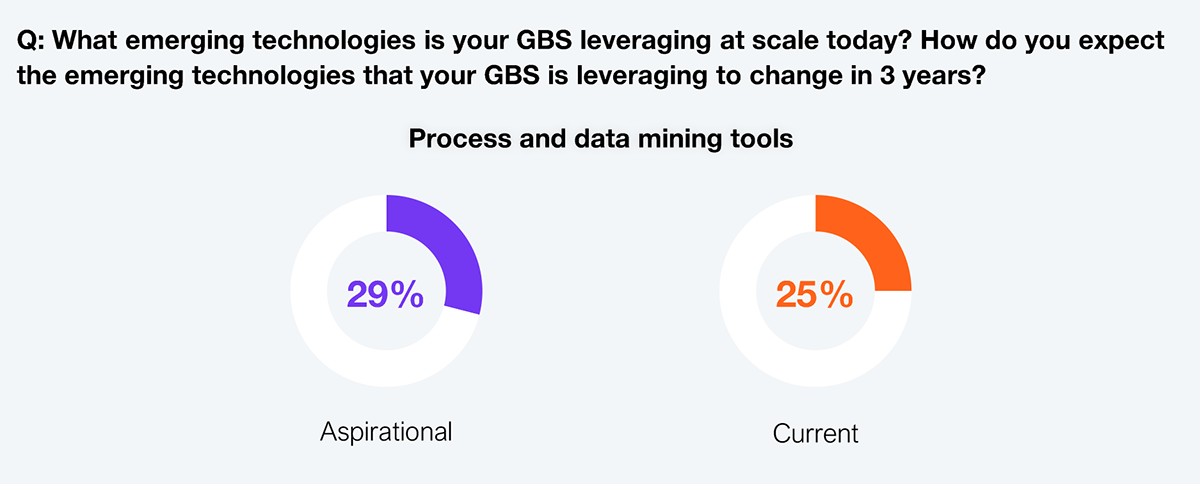AI alone isn’t moving the needle; broken processes are holding it back.
Enterprise leaders are investing heavily in AI, but many are realizing the real bottleneck isn’t in the model but the operating model. Most organizations are still flying blind regarding how work flows. Fragmented systems, siloed teams, and inconsistent data leave AI agents without the context to drive real decisions or take intelligent action.
Despite clear benefits, only 25% of global business services (GBS) organizations are leveraging process and data mining tools at scale today. Yet 29% say it’s a top aspiration. The gap between intent and execution remains (see Exhibit 1).
At the Celonis Process Intelligence Day in Bangalore, the core message was refreshingly grounded: AI will only be as effective as the processes it sits on top of. Without visibility into how the business runs, enterprises are throwing AI at symptoms but not dealing with the root causes.
With its deep concentration of Global Capability Centers (GCCs), India has become a high-stakes proving ground. It’s where operational complexity and digital ambition collide, and the pressure to ‘get AI right’ is highest.

Source: 510 GBS leader, HFS Research, 2025
Celonis is reframing the AI value equation. Instead of treating Process Intelligence (PI) as back-office plumbing, it’s being elevated as the digital operating system enterprises need to turn insights into execution. This isn’t about dashboards; it’s about turning real-time process data into coordinated, intelligent action across systems, bots, and humans.
The platform now spans several layers:
The value proposition is clear. Equip AI with the operational intelligence it needs to go beyond conversation and drive action.
The event showcased examples from large enterprises using PI to reduce working capital, spot supply chain anomalies, improve compliance, and streamline patient journeys. These aren’t lab experiments but business-critical programs.
One enterprise shared how layering process intelligence into its procure-to-pay workflow helped unlock over $100M in working capital by flagging inefficiencies in supplier terms and invoice cycles. This proves the scale is hard to ignore when PI is tied to outcomes.
However, what stood out was less the technology and more the operational mindset shift it requires:
India’s role is central here. The opening of Celonis’ new Bangalore office (including a dedicated strategy and innovation division, called ‘Celonis Garage’) signals a long-term investment in building execution expertise, not just technical capability. However, the real proof will come from how this local muscle translates into scalable, repeatable outcomes across global operations.
From an HFS lens, this event marks a step change in how PI is being positioned. It is no longer expected only to be a back-office tool but a strategic enabler of enterprise AI. While this is encouraging, the gap between visibility and value remains wide.
To close that gap, Celonis and its clients must move beyond showcasing product features and start doubling down on outcome accountability. This means identifying inefficiencies and tying interventions directly to business metrics and transformation goals. PI must also be more deeply embedded into enterprise change agendas, working in tandem with digital transformation teams and not operating in silos with process owners or analytics leads. And perhaps most importantly, the subsequent growth phase will depend on proving that PI can scale into judgment-heavy, less structured domains beyond the traditional finance and supply chain strongholds.
If they succeed, PI won’t just support AI; it will become the connective tissue that makes enterprise AI truly functional, scalable, and business-relevant.
Enterprise transformation leaders must stop treating process optimization as a secondary concern. The time for pilot purgatory is long gone. PI must be embedded directly into digital change agendas, budgeted accordingly, and governed by cross-functional leadership, not siloed analytics teams.
Getting there will take more than tech. It’ll take intent, ownership, and cross-functional execution. But if Celonis and its clients lean in, the shift from pilots to performance is well within reach.
Register now for immediate access of HFS' research, data and forward looking trends.
Get StartedIf you don't have an account, Register here |
Register now for immediate access of HFS' research, data and forward looking trends.
Get Started